Large | Bronze edition: 25 | Height: 25″
Study I | Bronze edition: 60 | Height: 18″
Study II | Bronze edition: 60 | Height: 17″
An Iroquois war party invading the Huron c.1649
“None of the most famous heroes of Rome have discovered a greater love of their country or a greater contempt of death than these people.”
Cadwallader Colden, 1727
“Among the Iroquois was to be found an intense spirit of nationality: for never since the days of Sparta were individual life and national life more completely fused into one.”
Francis Parkman, “Jesuits in North America”, 1867
“If these people are barbarous in deed, they have thoughts worthy of Greeks and Romans”
Fr.Jerome Lalemont, 1660

“I had always supposed heretofore that the paintings and busts that I had seen of the Roman Emperors, represented the ideal of artists rather than men who had actually ever existed….until I came to this country. For among these people I see everywhere the heads of Julius Caesar, Augustus, Pompey and others so strong and so powerful are their features!”
Fr. Paul Lejene,1634
“The best hope of the French lay in the Jesuit mission to the Huron: The future would have been full of hope, but for the portentous cloud of war that rose black and wrathful from where lay the dens of the Iroquois.”
F.P., 1867

“The Iroquois, at this time, (1640″s), were in a flush of unparalleled audacity. They despised white men as base poltroons and esteemed themselves warriors and heroes destined to conquer all mankind. They call themselves ‘Ongue-Onwhe’ that is ‘men surpassing all other men.’ “
F.P., 1867
“I had as leif be beset by goblins as by the Iroquois, the one are about as invisible as the other. Our people on the Richelieu and at Montreal are kept in a closer confinement than ever were monks and nuns in our smallest convents in France.”
Fr. Vimont, 1640
“They are regarded as formidable everywhere and are victorious over all with whom they have been at war… but what is more astonishing is that they actually do hold dominion over 500 leagues around.” (1500 miles) … it is therefore a marvel that so few can work such havoc and strike such terror into so many.”
Fr. Jerome Lalemont, 1660
“The way of waging war among the savages is so harsh that one must have a body of steel to bear the fatigues that they are obliged to undergo.”
Baron LaHontan, 1703
“They are robust and all are much taller than the French.”
Fr. Duperon, 1639
“It is {rightly} imagined in France that the Iroquois are of a ferocious aspect and that their very sight and name would strike terror into all who would encounter them. Generally speaking you would nowhere find finer looking men. The savages (Algonquins) are of a better build than the French but even so, side by side with the Iroquois these others seemed dwarfed.”
Fr.Bonin,1735
“Yet in them was often seen a native dignity of bearing which ocre and bear’s grease could not hide and comported well with their strong, symmetrical and sometimes majestic proportion.”
F.P.,1867
The year was 1649: “All was over with the Hurons. The death knell of their nation had struck” and with it the death of the Jesuit mission to the Huron. A premonition was fulfilled: “once when Jean Brebeuf was among the neutral nation in the winter of 1640, he beheld an ominous apparition of a giant cross slowly approaching from where lay the country of the Iroquois. He spoke of the vision to his comrades. What was it like? How large was it? Large enough, replied the priest, to crucify us all.”
F.P., 1867
Within a short time the other nations suffered the same fate: the Petun or Tobacco nation, the Neutral the Erie, the Susquehannock. All ceased to exist. From the Tennessee River in Northern Alabama to the solitudes above Lake Superior and from the Mississippi to the rugged coast of Acadia — throughout this vast extent of country “the forests trembled at the name of the Iroquois.”
F.P.,1867
“Perhaps we were so humbled last year and reduced to so low a state as not to be hit by the thunderbolts of the Iroquois who have turned their arms elsewhere and are Haughty enough to disdain conquests that are beneath them.”
Fr. Jerome Lalemont, 1661
“They come like foxes…they attack like lions…and they take flight like birds.”
Jesuit Relations, 1653
“My pen has no ink black enough to describe the fury of the Iroquois.”
Fr. Paul Rageneau, 1647







